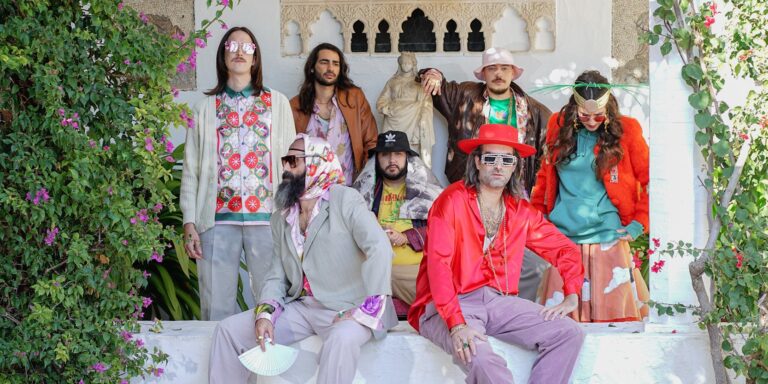OPINION:
The Andalusian group signs its most elaborate album to date, with fourteen new songs full of great collaborations that cover different styles and maintain their characteristic Andalusian seal as the common thread of the LP.
Conceived to be the soundtrack to “the New Andalusia,” the awaited new album by Califato 3/4 is a futuristic sonic journey trough the colorful world of flamenco music that manages to look forward into the future of the genre while maintaining a sense of authenticity and fidelity to its historic roots. There are moments in this album that sound strikingly conservative for what we are used to hearing from the band, (for example, in “ÇEGAOR” or “LIBRE ÇOY {TARANTÔ DE LIBERTÁ}”), and other moments that push their experimental approach even further, and it is in this combination of both old and new that the beauty of this record lies.
The album opens with title track, “ÊCCLABO DE LIBERTÁ”, which serves as an instrumental introduction that successfully manages to blend different genres of Spanish music and progresses beautifully. Although it might not be the most memorable song in the bunch, it manages to create an immersive atmosphere and accustoms our ears to the world of sound that they are about to create.
Following the tittle track we get the previously mentioned “ÇEGAOR” (featuring Ángeles Rusó, Paula Margo and Anaisa García). This track starts off as an ambient infused flamenco piece, that instantly makes me think of “La Nana del Caballo Grande” by the great Camarón dela Isla. The track is beautiful but I feel like the placement in the album breaks the flow a little bit as it feels like the first two tracks act as a two different introductions. Taking into account the massive change of pace we get after this track, I feel like “ÇEGAOR” could have worked better in the middle of the album, almost acting as an interlude
It is at this point in the album where we get what is in my opinion the most solid run of bangers that I have heard in a while from a Spanish pop artist. Every single track in the middle section of the album, from “XANCLA LEBANTÁ” to “VAMPIRO GÜENO” is catchy, experimental, exciting and original. Despite the fact that every track explores the same sonic concept of flamenco-infused hip hop and EDM, each track offers a different perspective by choosing to fuse different sub-genres of hip hop and offering a very wide range of instrumentations and guests. “XANCLA LEBANTÁ” and “DIME DÓNDE BÂ – A BENDÊH TOMATÊH-“ are two absolute bangers that explore the obvious but unfortunately unexplored sonic relationship between flamenco and music of the Middle East, while at the same time offers two of the most catchy choruses and witty hilarious pieces of storytelling in the whole album.
Although the lyrics of “TÛ CADEN” are simple and short, with so little Califato 3/4 manage to beautifully portray the feeling of despair in a toxic relationship. However it is instrumentally that this song becomes really interesting. What starts as a simple beautifully arranged song, slowly progresses into a broken beat drum solo and some loud rave-ish 808s. This sound is explored even further in the exhilarating “ER PATIO DE LÔ HIRGERÔ”, which is constantly building up, edging the listener for a drop that never quite comes, which in my opinion makes the track even more interesting.
“DE LA FRONTERA” is a hard hitting hip hop track which in both style and vibe reminds me a lot of the iconic “Blacker the Berry” by Kendrick Lamar, but of course in a very Andalusian vocal delivery by guest artists Abocajarro and Carmen Xía.
Unfortunately the amazing run of songs comes to an end with “ÊL-LABONÊ”, which really is a shame because I think this track has much potential, however, it feels empty and unfinished and the uninspired vocal performance by guest artist Perrate makes the track fall flat despite the various instrumental switch ups. “PIPÂ DEL ELEFANTE” picks up the pace a bit and offers a more enjoyable listening experience than the previous track, although compared to the quality of the rest of the album, the song feels redundant.
However the band ends the album fantastically. “ANDALUÇÊ YORÁ” is a touching, experimental track, that calls back to the ambient textures of “ÇEGAOR” at the beginning of the album, while “ÇILENÇIO ∞” repeats the formula of Califato’s biggest hit “Crîtto de lâ Nabahâ” by taking the music that you would usually hear in Spain during Semana Santa and converting it into a hard hitting EDM track, although this time I feel like the attempt is even more successful, as it manages to create more exciting climaxes.
Although this is definitely Califato 3/4’s best album to date in terms of the individual quality of each track, I still feel like the overall listening experience suffers a bit from a lack of cohesion, which might have something to do with the placement of each track or a couple tracks being weaker in quality. Despite the fact that the music presented here is exciting, catchy and most importantly, unique, I still feel like Califato 3/4 are far from reaching their full potential, which makes me look forward to what they could come up with next and makes them one of the most exciting artists in the underground music scene in Spain at the moment.
7.5/10
Photography: Adrián del Campo
About the Author
Spanish musician Salvador Sánchez is currently settled in London, where he develops his international career as a pianist and a composer, with the intention of bringing classical and experimental music to the forefront of the music scene, by collaborating with different artists across all disciplines and bringing this music to unconventional stages.


